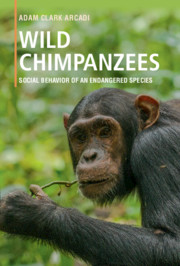Book contents
- Wild Chimpanzees
- Wild Chimpanzees
- Copyright page
- Dedication
- Contents
- Preface
- 1 Primates, Apes, and the Study of Chimpanzee Social Behavior
- 2 Seven Long-Term Field Studies
- 3 Chimpanzee Fission–Fusion Social Organization and Its Conservation Implications
- 4 Sex Differences in Ranging and Association Patterns
- 5 Female Social Relationships
- 6 Male Social Relationships
- 7 Sexual Behavior: Conflicting Strategies of Males and Females
- 8 Coalitionary Lethal Aggression between and within Communities
- 9 Hunting, Eating, and Sharing Meat
- 10 Communication: The Form and Content of Signals
- 11 Community Differences in Grooming Postures and Tool Use: Innovation, Social Learning, and the Question of “Culture”
- Epilogue
- Appendix: Field Methods for Studying Wild Chimpanzees
- End Notes
- References
- Index
- Plate Section (PDF Only)
7 - Sexual Behavior: Conflicting Strategies of Males and Females
Published online by Cambridge University Press: 01 June 2018
- Wild Chimpanzees
- Wild Chimpanzees
- Copyright page
- Dedication
- Contents
- Preface
- 1 Primates, Apes, and the Study of Chimpanzee Social Behavior
- 2 Seven Long-Term Field Studies
- 3 Chimpanzee Fission–Fusion Social Organization and Its Conservation Implications
- 4 Sex Differences in Ranging and Association Patterns
- 5 Female Social Relationships
- 6 Male Social Relationships
- 7 Sexual Behavior: Conflicting Strategies of Males and Females
- 8 Coalitionary Lethal Aggression between and within Communities
- 9 Hunting, Eating, and Sharing Meat
- 10 Communication: The Form and Content of Signals
- 11 Community Differences in Grooming Postures and Tool Use: Innovation, Social Learning, and the Question of “Culture”
- Epilogue
- Appendix: Field Methods for Studying Wild Chimpanzees
- End Notes
- References
- Index
- Plate Section (PDF Only)
Summary
OVERVIEW
Wild chimpanzee sexual behavior is remarkable in several respects and offers a crucial window into the dynamics of chimpanzee social life generally. In the two- to three-week period leading up to ovulation within the roughly thirty-six-day menstrual cycle, a female's anogenital area swells dramatically, an estrogen-induced phenomenon resulting in a bulbous, bright pink protuberance 900 to 1,400 cubic centimeters in size (e.g., twice the size of a grapefruit) (Plate 7). Estrous swellings are thus highly visible signals of a female's approximate reproductive state. They attract males of all ages, and the majority of sexual behavior in chimpanzees occurs when females are maximally swollen. Since females do not cycle for several years after giving birth to an infant that survives to weaning, competition between males to mate with females that have resumed cycling is intense. Party sizes increase when swollen females are present, bringing many competing males together into what often become highly charged social contexts. Observers have documented a variety of tactics used by males to gain mating access to females at these times.
Mature female chimpanzees, for their part, typically mate an extraordinary number of times when they are in estrus. Swollen females mate withmost or all of themales in their community, including adolescents, juveniles, and even infants. Hourly copulation rates for females have been calculated to be between less than one to nearly five per hour at five different field sites, with females mating more often when more males are present. In a study at Ngogo spanning six years, individual females mated with between twenty-eight and thirty-eight differentmales when fully swollen. In a notable case, one female was observed to copulate sixty-five times with eighteen males in one day. A typical estrous period thus includes hundreds of matings – the record number observed at Ngogo for a single estrous period was 439. Astoundingly, since females usually experience numerous estrous cycles before fertilization, estimates of the average number of times a female copulates per conception range from more than 400 to several thousand.
Despite their high copulation rates with large numbers of males, when and with whom females mate is not random. As noted, sexual activity occurs primarily when females are maximally swollen.
- Type
- Chapter
- Information
- Wild ChimpanzeesSocial Behavior of an Endangered Species, pp. 57 - 64Publisher: Cambridge University PressPrint publication year: 2018



